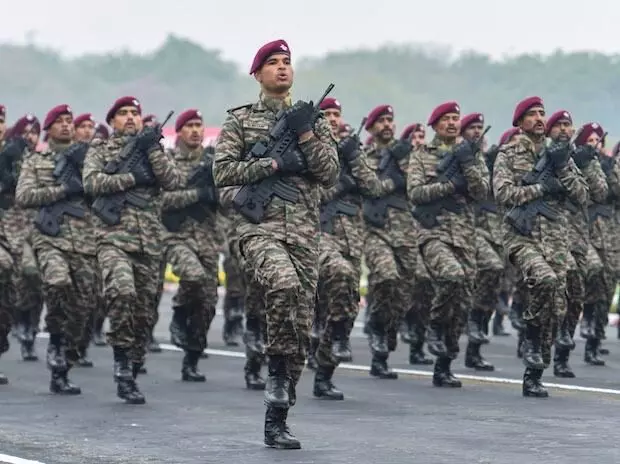Innovation at the frontlines
In 2024, thematically dubbed as the ‘Year of Technology Absorption’, the Indian Army eyes to leverage its in-house expertise and innovative prowess to meet high-end operational and logistic requirements across wide-ranging applications in the fast-evolving warfare domain

The Indian Army, in addition to emphasizing combat prowess, declared its commitment to observe the current year (2024) with significant strides in ‘Technology Advancement,’ highlighting technology as a catalyst for transformation. This announcement was
made during the annual press conference on Thursday. Chief of Army Staff General Manoj Pande, in a prelude to the Army Day, elaborated that the Indian Army would leverage in-house expertise to innovate solutions for operational and llogistic requirements, collaborating with the domestic defence industry. As a first move in this initiative, it was declared that a secure Army Mobile with the indigenous operating system ‘Bha-
rOS’ has been developed through Project SAMBHAV in collaboration with IIT Madras. This achievement ensures pan-India secure communication even when utilizing the existing civil network. Operating on state-of-the-art contemporary 54 technologies, it represents a significant leap forward in India’s defence capability.
To enhance cyber security, specialist subunits designated as COMMAND CYBER OPERATION & SUPPORT WINGS (CCOSW) have been raised at the Field Army Level. Army personnel are undergoing training to operate within this system through institutionalized, procedural, and technological measures. In a major move, the Indian Army plans to induct linguists and cyber experts into the Territorial Army to enhance counter-insurgency operations through civil-military fusion. The Territorial Army’s provisions have been utilized to com-mission officers in specialist fields, with five officers commissioned as linguists in the past year. Following a similar approach, cyber experts will also be inducted to create a pool of specialist cadre.General Pande emphasized the pivotal role of technology as catalyst for transformative change, stating, “This theme underscores our commitment to leverage technology as a catalyst for transformative change, as well as to utilize in-house expertise to innovate solutions to our operational and logistic requirements and give shape to these projects in collaboration with the domestic defence indus-try,” during his address at the Manekshaw Centre in the national capital. In addition to technological advancements, the Indian Army plans to undertake major transformative schemes in employment, aiming to empower veterans through skilling programs. Under the ‘Kaushal Veer’ scheme, soldiers, including Agniveers, have been provided with skill certificates according to global industry standards. This project leverages the provisions of the National Education Policy and National Credit Framework. General Pande highlighted the induction of better vehicles, drones, and coun-ter-drone systems as part of the Army’s emergency provisions. The restructuring of artillery units and reduced reliance on animals in transport units underscore the Army’s commitment to modernization and adaptability in evolving warfare domains.In the pursuit of innovation, the Indian Army places a strong emphasis on fostering creativity at the unit level. The Army Design Bureau (ADB) has identified and selected 34 of 80 in-house innovations, spanning cutting-edge technologies, including AI, software applications, unmanned aerial platforms, and counter-drone systems. This collaborative approach involves partnering with academic and industry entities to developruggedized solutions that meet military-grade standards. The Army Design Bureau’s initiatives extend to integrating the capabilities of the entire defence industry ecosystem. Collaborations with premier academic experts, such as the Foundation for Innovation and Technology Transfer, IIT Delhi, identified fifteen niche tech innovations last year, with eight already undergoing the Intellectual Property Rights process.The collaborative effort with academia continues, with four niche tech innovations currently in progress under the guid-ance of faculty from IIT Delhi through the Army Technology Board route. A notable success in this innovation journey is “Vidyut Rakshak,” an IoT-based Generator Monitoring and Control System, which has transitioned to the Indian industry for mass production. In addressing the labour-intensive and time-consuming aspects of intelligence data collection, AI-driven software has been developed, providing dynamic graphical representation and offering informative graphs that reveal hidden trends and patterns, thereby enhancing situational comprehension. Another significant stride in innovation is the ‘Military Objects Detection System’ in Satellite Images.This AI-based system enables the automatic detection and classification of military objects in satellite imagery in real time. The developed AI module enhances Intelligence,Surveillance, and Reconnaissance capabilities, empowering commanders at all levels to make timely decisions. In-house research and development efforts of the Indian Army have also given rise to the ‘Multipurpose Octocopter,’ a versatile tool with a payload capacity of 25 kg in high-altitude areas, serving various functions such as delivering essential supplies to forward posts, conducting surveillance operations, and offering a live camera feed to the operator. Additionally, it features a platform for firing assault rifles and throwing grenades, showcasing its multi-faceted utility.



